音声補助装置市場:現状分析と予測(2023~2030年)
タイプ別(電子喉頭音声補助装置、音声生成装置など)、適応症別(失語症、喉頭関連疾患など)、地域/国別の重点分析
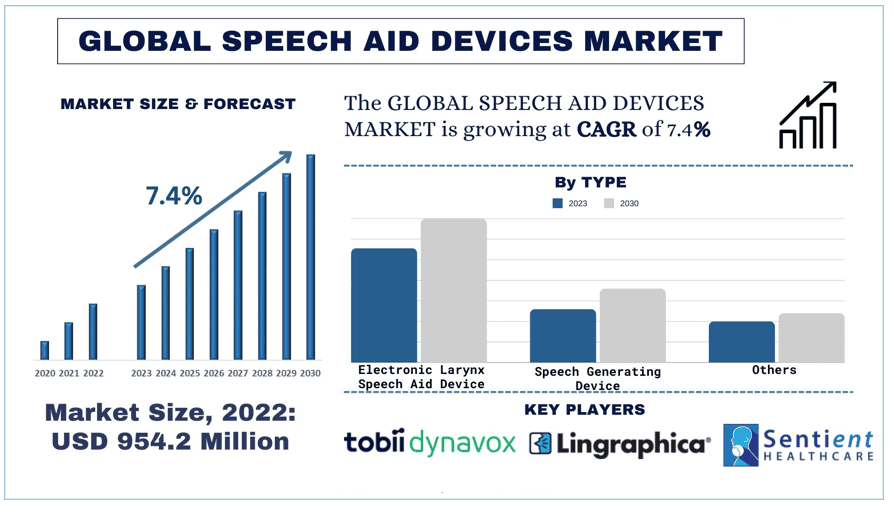
音声補助装置市場規模と予測
音声補助装置市場は、2022年には9億5420万米ドルと評価され、予測期間(2023~2030年)に約7.4%の力強いCAGRで成長すると予測されています。音声補助装置に関する技術的進歩の高まりにより。
音声補助装置市場分析
音声補助装置市場は、喉頭がんの症例の増加、研究開発活動の増加、戦略的提携の増加、および技術的進歩の増加など、いくつかの理由により拡大しています。人工知能と音声補助装置の統合も、市場の成長を牽引しています。
米国国立がん研究所によると、喉頭がんは、米国のすべての新しいがん症例の0.6%を占めています。
さらに、2022年3月、Altec Inc.は、代替および補助コミュニケーション(AAC)デバイスであるMyoVoiceが、自然な発話を置き換える能力を評価するための臨床試験を開始しました。このAACデバイスは、喉頭がんや咽頭がんの手術治療によって発生した音声障害を持つ人々のコミュニケーションを回復するために、音声筋肉から非侵襲的に記録された電気信号を使用します。このような研究開発活動は、予測期間中の市場の成長を牽引しています。
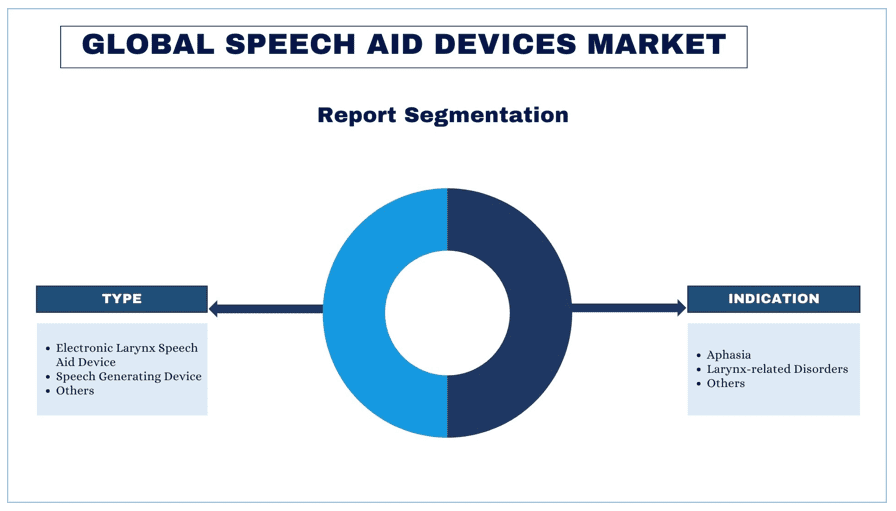
音声補助装置市場動向
このセクションでは、当社の調査専門家チームが特定した、音声補助装置市場のさまざまなセグメントに影響を与えている主要な市場動向について説明します。
音声生成装置が業界標準を変革
音声生成装置(SGD)は、代替および補助コミュニケーション(AAC)デバイスとしても知られ、コミュニケーション障害を持つ個人が自己表現するのを支援するために設計された電子ツールです。これらのデバイスは、脳性麻痺、自閉症、ALS(筋萎縮性側索硬化症)、脳卒中、または外傷性脳損傷などの状態を持つ人々に特に役立ちます。これらのデバイスは、個人が社会的な交流に参加し、日常生活にさらに積極的に関わることを可能にする上で重要な役割を果たしています。彼らは、ユーザーに自分の考え、ニーズ、感情を効果的に伝える手段を与えることによって、生活の質を大幅に向上させることができます。進行中の技術的進歩は、市場におけるこれらのデバイスの成長をさらに促進します。たとえば、2020年9月、Control Bionicsは、代替および補助コミュニケーション(AAC)デバイスラインに、脊髄性筋萎縮症(SMA)、脳性麻痺、脊髄損傷など、さまざまな病状を持つ人々の支援を目的とした、神経ベースの音声出力コミュニケーション補助具であるGridPad Trilogyコミュニケーションソリューションを追加すると発表しました。
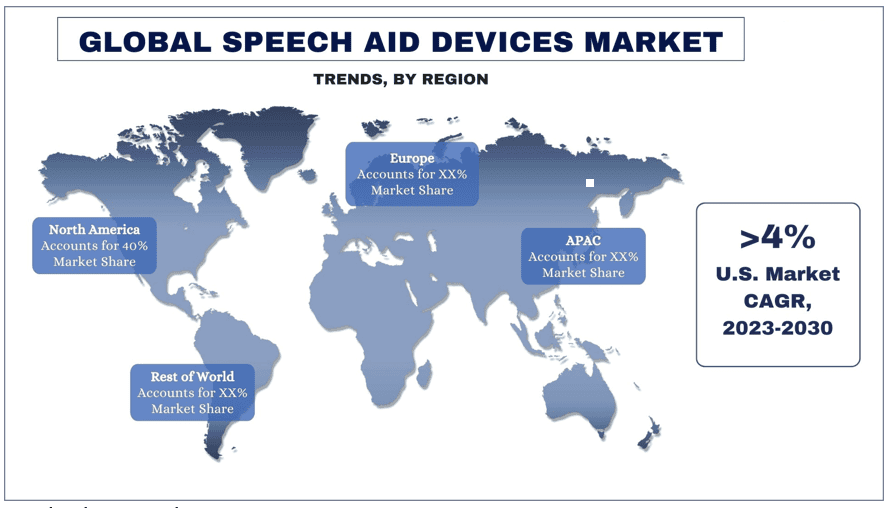
北米は、予測期間中に著しいCAGRで成長すると予想
北米内では、米国が市場の主要なシェアを占めています。同国における市場の成長を後押しする主な要因は、口腔がんや失語症の症例の増加、技術的進歩の高まり、研究開発活動の増加、研究開発への注力の高まり、確立されたヘルスケアインフラ、およびいくつかの市場プレーヤーの存在です。
によると米国がん協会によると、2024年には、米国の喉頭がんについて、約12,650例の新規症例(男性10,030例、女性2,620例)が推定されています。
2023年11月、米国デューク大学神経外科のデューク神経科学者、外科医、エンジニアの共同チームは、人の脳信号を彼らが伝えようとしていることに変換できる音声プロテーゼを開発しました。この新しい技術は、神経疾患のために発話できなくなった人々が、脳コンピュータインターフェースを通じてコミュニケーション能力を取り戻すのに役立ちます。
音声補助装置業界の概要
音声補助装置市場は競争が激しく、いくつかのグローバルおよび国際的な市場プレーヤーが存在します。主要プレーヤーは、パートナーシップ、合意、コラボレーション、新製品の発売、地理的拡大、合併および買収など、市場でのプレゼンスを高めるためのさまざまな成長戦略を採用しています。市場で活動している主なプレーヤーには、Tobii Dynavox AB、PRC-Saltillo、Lingraphica、Atos Medical US、Attainment Company, Inc.、Jabbla、Sentient Healthcare、Luminaud, Inc.、Nu-Vois LLC、Andreas Fahl Medizintechnik-Vertrieb GmbHがあります。
音声補助装置市場ニュース
- 2023年3月、3月、Aural Analyticsの音声バイタルソフトウェアは、筋萎縮性側索硬化症(ALS)を患っている患者を支援するために、米国食品医薬品局(FDA)から画期的デバイス指定を受けました。
- 2022年2月、Tobii Dynavoxは、自閉症、脳性麻痺、失語症などの音声障害と身体障害を持つ個人のニーズに合うように、超堅牢な設計と強力なパフォーマンスを備えた、代替および補助コミュニケーション(AAC)用のタッチベースの音声生成デバイスであるTD I-110を発売しました。
- 2021年10月、Tobii Dynavoxは、コミュニケーション補助具における革新を可能にするために、Acapela Groupを買収しました。
- 2021年9月、EyeTech Digital Systemsは、言語障害のある個人のための迅速かつ効果的なコミュニケーションとして、代替および補助コミュニケーション(AAC)製品ポートフォリオに、新しい10インチ音声生成デバイス(SGD)であるEyeOn Goのリリースを発表しました。このデバイスを使用すると、記号またはテキストベースのコミュニケーションを使用して、ユーザーはすばやく簡単に単語や文章を生成し、その後、読み上げたり、内蔵のメッセージングアプリを介して共有したりできます。
- 2021年6月、Tobii DynavoxとAdvantechは共同で、身体的な課題を持つ人々がコミュニケーションできるように、競合他社とは一線を画す次世代IシリーズAACデバイスを共同で作成しました。
音声補助装置市場レポートの対象範囲
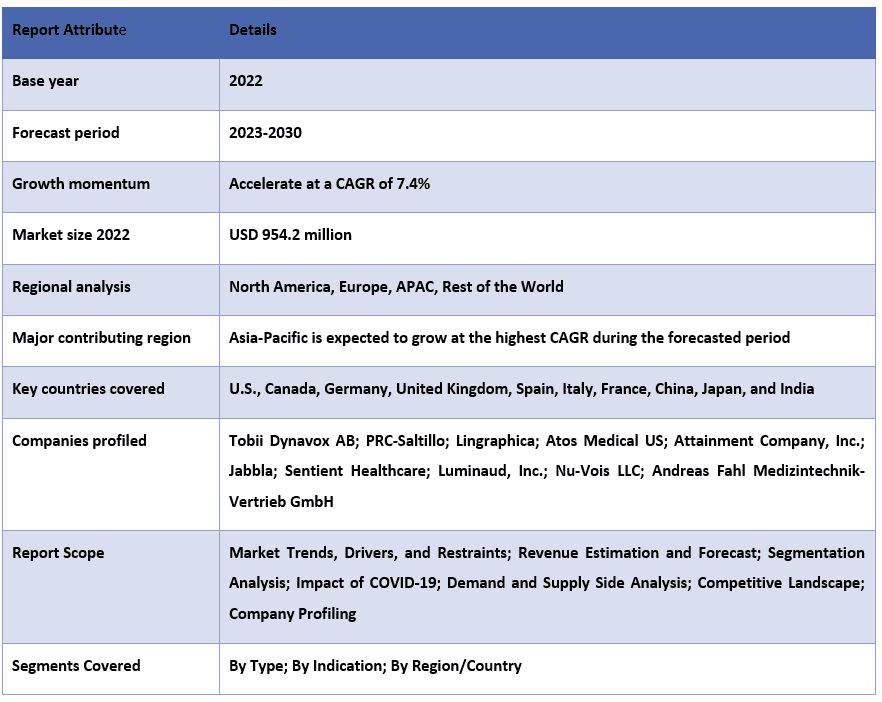
このレポートを購入する理由:
- この調査には、認証された主要な業界専門家によって検証された市場規模と予測分析が含まれています。
- このレポートは、業界全体のパフォーマンスを簡単に確認できます。
- このレポートは、主要な事業財務、製品ポートフォリオ、拡張戦略、および最近の開発に焦点を当てて、著名な業界関係者の詳細な分析をカバーしています。
- 業界で蔓延しているドライバー、抑制要因、主要トレンド、および機会の詳細な検討。
- この調査は、さまざまなセグメントにわたる市場を包括的にカバーしています。
- 業界の深層レベルの地域分析。
カスタマイズオプション:
グローバル音声補助装置市場は、要件または他の市場セグメントごとにさらにカスタマイズできます。これに加えて、UMIは、お客様独自のビジネスニーズがあることを理解しています。したがって、お客様の要件に完全に適合するレポートを入手するために、お気軽にお問い合わせください。
目次
音声補助装置市場分析(2023~2030年)の研究方法論
世界の音声補助装置市場の採用を分析するために、過去の市場の分析、現在の市場の推定、および世界の音声補助装置市場の将来の予測という3つの主要なステップが行われました。過去の市場規模を収集し、現在の市場規模を推定するために、徹底的な二次調査が実施されました。次に、これらの洞察を検証するために、多数の知見と仮定が考慮されました。さらに、世界の音声補助装置市場のバリューチェーン全体にわたる業界専門家との徹底的な一次インタビューも実施されました。一次インタビューを通じて市場規模の仮定と検証を行った後、トップダウン/ボトムアップアプローチを採用して、完全な市場規模を予測しました。その後、市場の細分化とデータの三角測量法を採用して、業界のセグメントとサブセグメントの市場規模を推定および分析しました。詳細な方法論を以下に説明します。
過去の市場規模の分析
ステップ1:二次資料の詳細な調査:
企業の内部資料(年次報告書と財務諸表、業績発表、プレスリリースなど)を通じて、音声補助装置市場の過去の市場規模を取得するために、詳細な二次調査が実施されました。および外部資料には以下が含まれますジャーナル、ニュースと記事、政府発行物、競合他社の発行物、セクターレポート、サードパーティデータベース、およびその他の信頼できる発行物。
ステップ2:市場セグメンテーション:
音声補助装置市場の過去の市場規模を取得した後、主要地域におけるさまざまなセグメントとサブセグメントの過去の市場インサイトとシェアを収集するために、詳細な二次分析を実施しました。主要なセグメントは、タイプ、適応症、および地域としてレポートに含まれています。さらに、その地域における試験モデルの全体的な採用を評価するために、国レベルの分析が実施されました。
ステップ3:要因分析:
さまざまなセグメントとサブセグメントの過去の市場規模を取得した後、要因分析を実施して、音声補助装置市場の現在の市場規模を推定しました。さらに、音声補助装置市場のタイプ、適応症、地域などの従属変数と独立変数を使用して要因分析を実施しました。世界の音声補助装置市場セクターにおける主要なパートナーシップ、合併と買収、事業拡大、および製品発売を考慮して、需要と供給の両方のシナリオについて徹底的な分析が実施されました。
現在の市場規模の推定と予測
現在の市場規模の推定:上記の3つのステップからの実用的な洞察に基づいて、現在の市場規模、世界の音声補助装置市場の主要プレーヤー、およびセグメントの市場シェアに到達しました。必要なすべてのパーセンテージシェア分割と市場の内訳は、上記に記載された二次アプローチを使用して決定され、一次インタビューを通じて検証されました。
推定と予測:市場の推定と予測のために、推進要因と傾向、制約、および関係者が利用可能な機会を含むさまざまな要因に重みが割り当てられました。これらの要因を分析した後、関連する予測手法、つまりトップダウン/ボトムアップアプローチを適用して、主要市場全体におけるさまざまなセグメントとサブセグメントについて2030年の市場予測に到達しました。市場規模の推定に採用された調査方法には以下が含まれます:
- 収益(米ドル)の観点からの業界の市場規模と、主要市場全体における音声補助装置市場の採用率
- 市場セグメントとサブセグメントのすべてのパーセンテージシェア、分割、および内訳
- 提供される製品の観点からの世界の音声補助装置市場の主要プレーヤー。また、この急速に成長している市場で競争するためのこれらのプレーヤーによって採用された成長戦略
市場規模とシェアの検証
一次調査:主要地域全体のトップレベルエグゼクティブ(CXO/VP、セールスヘッド、マーケティングヘッド、オペレーションヘッド、リージョナルヘッド、カントリーヘッドなど)を含む主要オピニオンリーダー(KOL)との詳細なインタビューが実施されました。一次調査の結果が要約され、統計分析が実行されて、述べられた仮説が証明されました。一次調査からの入力は二次的な結果と統合され、情報を実用的な洞察に変えました。
さまざまな地域における一次参加者の分割
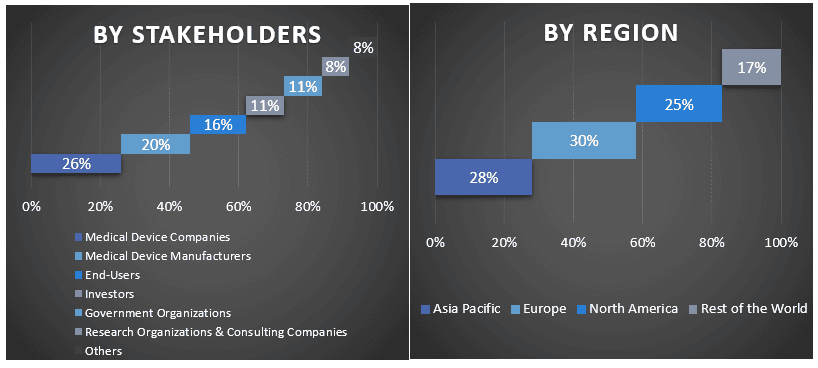
市場エンジニアリング
データの三角測量手法を採用して、全体的な市場推定を完了し、世界の音声補助装置市場の各セグメントとサブセグメントについて正確な統計数値を導き出しました。データは、世界の音声補助装置市場におけるタイプ、適応症、および地域の分野におけるさまざまなパラメータと傾向を調査した後、いくつかのセグメントとサブセグメントに分割されました。
世界の音声補助装置市場調査の主な目的
世界の音声補助装置市場の現在のおよび将来の市場トレンドがこの調査で特定されました。投資家は、この調査で実施された定性分析および定量分析に基づいて、投資に対する裁量権を決定するための戦略的洞察を得ることができます。現在のおよび将来の市場トレンドは、地域レベルでの市場の全体的な魅力を決定し、業界参加者が未開拓市場を最大限に活用して、ファーストムーバーの利点を享受するためのプラットフォームを提供しました。調査のその他の定量的な目標には以下が含まれます:
- 音声補助装置市場の現在の市場規模と予測市場規模を価値(米ドル)の観点から分析します。また、さまざまなセグメントとサブセグメントの現在の市場規模と予測市場規模を分析します
- この調査のセグメントには、タイプ、適応症、および地域の分野が含まれます
- 音声補助装置業界の規制枠組みを定義および分析します
- さまざまな仲介業者の存在に関連するバリューチェーンを分析し、業界の顧客と競合他社の行動を分析します
- 主要地域の音声補助装置市場の現在の市場規模と予測市場規模を分析します
- レポートで調査された主要な地域の国には、アジア太平洋、ヨーロッパ、北米、およびその他の地域が含まれます
- 音声補助装置市場の企業プロファイルと、急速に成長している市場で持続するための市場プレーヤーによって採用された成長戦略
- 業界の詳細な地域レベル分析
よくある質問 よくある質問
Q1: 音声補助装置市場の現在の市場規模と成長潜在力は?
Q2: 音声補助装置市場の成長を促進している要因は何ですか?
Q3: 種類別に見て、音声補助装置市場で最大のシェアを占めているセグメントは?
Q4: 音声補助装置市場における新たな技術とトレンドは何ですか?
Q5: どの地域が音声補助装置市場を支配するでしょうか?
関連 レポート
この商品を購入したお客様はこれも購入しました










